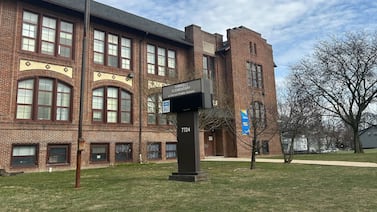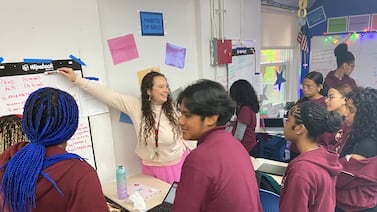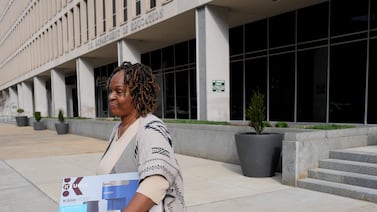With little fanfare in January, Illinois debuted an upgraded collection of online courses featuring hundreds of classes from agriscience to anthropology offered by multiple providers. They were available to any school in the state.
Within months, the global coronavirus pandemic shut down school campuses and pushed every student in the state into remote learning.
The state’s fortuitously timed redesign was poised to fill a desperate new need — education delivered via the internet. But oddly enough, the courses under the state umbrella have remained unnoticed in some areas, even as school districts rushed toward remote learning.
While states like Virginia expanded their virtual programs and made them free to schools, Illinois can’t even say how many students have taken advantage of its online courses this spring. The state didn’t mention its new catalog in its remote learning guidance — and it hasn’t explained how it plans to advertise its program in the months to come.
With the redesign, Illinois kept the non-profit Illinois Virtual School that is run out of Peoria, and added five private providers into the mix. But one of those new online course providers, the experienced Arizona State University, attracted no — zero — Illinois students. And some district leaders still know little to nothing about the newly expanded catalog of courses.
Meanwhile, the state’s decision to expand the number of providers — ostensibly so more students could choose from a larger menu of courses — left less money for its existing familiar program, which was seeing a sudden increase in demand.
The Illinois Virtual School lost a state grant that had accounted for nearly half of its operating budget. It slashed its budget more than 18%, to $1.8 million, and cut teacher salaries by 30% to keep courses available. As demand surges, some of its courses have hit capacity, but the school has scant resources to hire more teachers.
Now, federal aid intended precisely to shore up remote learning could boost the state’s efforts. But it’s not certain what Illinois’ plan is to seize that opportunity.
It’s also not clear why the state’s expanded menu of courses hasn’t been a savior to desperate districts, but observers say an inflexible enrollment date, a specific mission to only supplement learning, and a lack of broad awareness about the five new providers may have hampered enrollment.
Virtual learning experts suggest this is the moment for Illinois to spotlight what it’s built for remote learning.
States should tap into existing structures for virtual learning, said John Watson, head of the national Digital Learning Collaborative. “That seems like a wasted opportunity,” he said, when they don’t do so.
In Illinois, an early wave
When Pamela Shaw’s son was struggling under the social and academic demands of the transition to high school, she turned to the Illinois Virtual School. Shaw, a music instructor at the non-profit course provider, enrolled her son in English and algebra that he could take from home.
Within a year, he was back at his school, and ready for its challenges. With the support of the online courses, he was able to graduate on time.
“If we hadn’t had that as an option, it would have been rough,” said Shaw, who has been a remote learning instructor for eight years.
Since 2001, Illinois, among an early wave of states turning to the internet to augment education, has subsidized remote learning for families like the Shaws, while also providing flexible work for teachers. Today, it is among 24 states that run their own network of courses.
Other states opened the door early to for-profit and non-profit providers, a mix of universities and startups, charging tuition for online courses.
In Illinois, the Illinois Virtual School was the sole statewide provider of courses, first run by the State Board of Education, and now by the Peoria Regional Office of Education.
Students who signed up for the Illinois Virtual School included those seeking to make up classes that they failed to pass but needed for graduation, students who want to take online courses to free up their schedule for other classes, part-time students, and those with disabilities that keep them from classrooms.
A district or school could purchase an entire chemistry class, or a credit recovery course for one student seeking to make up a class to graduate.
As the teacher shortage crisis grew, particularly in downstate rural communities, the remote learning program sought to fill the gap in hundreds of schools that couldn’t find or afford qualified teachers for subjects like Mandarin, Spanish as a foreign language, or high school math and science.
The school, on average, has served about 7,000 students a year from 600 partner schools. However, a state school board member in May 2019 questioned whether its completion rate — 90% of students scoring a passing grade or higher over four years — signaled good performance.
The landscape shifts
Then came a shift, after a committee appointed by then-Gov. Bruce Rauner, a Republican, recommended opening up virtual learning to multiple providers.
The committee drew inspiration from Louisiana’s state-run remote program, the first in the nation, which included both in- and out-of-state, and for-profit and nonprofit providers.
Illinois’ new catalog, launched in January after a stop-and-start request for proposals spanning several years and two state boards, offered districts, schools, and families courses and teacher training from the virtual school itself, plus courses from Apex Learning, Arizona State University Prep Global Academy, BCG-North American Co., Edgenuity, and Edmentum. (BCG-North American Co., Edgenuity and Edmentum did not respond to requests for comment. Apex declined to comment for this story.)
The cost per student generally runs from $90 to $350 per course per semester, which is paid up front by families or districts, who then apply for a reimbursement from the state board. When it sought course providers, the state board suggested that subsidies for classes would not exceed $6 million over five years. The state’s catalog now offers 840 accredited courses for students from middle through high school.
Enter the pandemic
The state could help meet a huge need for remote classes. But officials have stressed that their course catalog was designed only to provide supplemental instruction. So far, they seem to do just that.
In March operators lacked the flexibility to adapt to the pandemic emergency. Just when districts most needed to arrange courses — shortly after school buildings were shut down, a survey of Illinois school leaders showed that two-thirds felt unprepared for remote learning — enrollment in the state’s new privately offered courses was closed. It only opened again in March, for summer classes.
It’s not clear how many districts or schools are enrolling students, because state officials say they don’t get reports until requests for reimbursement come in. The state has also not yet decided to what degree it will subsidize summer courses.
The Illinois Virtual School, meanwhile, did accept mid-semester enrollees. It has hired 11 more teachers to meet an increase in demand and more than double its per-course enrollment for the summer session from its usual 175 students to 450 students.
But having lost much of their state funding, the virtual program’s officials said they’re struggling to meet the surge in demand.
Kip Pygman, the head of the Illinois Virtual School, said he is concerned that rules prohibit the school from negotiating prices, thus putting courses out of reach of districts that can’t afford them, particularly those interested in large-scale partnership.
Cynthia Hamblin, a longtime advocate for virtual education in Illinois and the one-time head of the Illinois Virtual School, believes the budget cuts have weakened the program.
“They have years of online experience in delivering programs, in teachers teaching online, and I hope the state would be tapping into that expertise,” said Hamblin, who now heads the Virtual Learning Leadership Alliance.
A missed opportunity?
Even so, some districts remained in the dark.
Teresa Lance, assistant superintendent for Equity and Innovation in Illinois Unit District 46, said she had never heard of the course catalog.
“We have had several teachers who had to go out on long-term leave, but we have not engaged in remote learning to support students when teachers are out,” she said.
The Illinois Virtual School, meanwhile, can draw upon two decades of name recognition to attract interest.
The Leyden Community High School District #212 district, in a Chicago suburb near O’Hare Airport, regularly turned to the Illinois Virtual School for long-term substitutes or make-up courses for students.
“We appreciate the fact that it is local, and we can work with them directly,” Superintendent Nick Polyak said.
State-run virtual schools will get an additional boost from federal coronavirus relief earmarked for the hardest-hit states to expand virtual education. The Illinois State Board of Education plans to apply for funding.
But long term, advocates worry that competition will further hurt the Illinois Virtual School.
For example, the national group Quality Matters reviews courses for quality to help would-be partners, but charges $1,000 per review — which the cash-trapped Illinois Virtual School may struggle to pay.
More broadly, to make virtual learning more attractive and successful, the state would have to ensure that schools issue blanket approval for virtual credits for graduation, rather than weighing them case by case as it does now, said Timothy Dohrer, education professor at Northwestern University.
He is also concerned that the catalog doesn’t provide a way to assess the value of each course, as the state report card does for schools themselves.
And the Illinois Federation of Teachers wants the state to invest in supports for classroom teachers moving to remote learning, rather than bringing in out-of-state companies to teach.
The Illinois Virtual School is trying to fill a growing need, via partnership with National Louis Teachers College to train teachers in remote learning. Arizona State University, and other private providers, are also expanding in that direction.
It’s possible that teaching teachers may provide the most growth in enrollment.
“We’ve moved toward training and upscaling teachers that were classroom teachers and needed to go digital,” Lisa Edgar, of Arizona State University, said. “No teacher should be thrown into online learning.”







